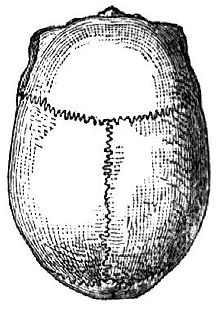Dolichocephaly
| Classification according to ICD-10 | |
|---|---|
| Q67.2 | Dolichocephaly |
| ICD-10 online (WHO version 2019) | |
The term dolichocephaly (also dolichocephaly, Greek δολιχός dolichos 'long'; κεφαλή kephalē 'head') is used in human medicine to describe a special head shape that is characterized by an asymmetrically long, narrow skull shape (long skull). This skull deformation is neither artificial nor caused by other external circumstances, but rather due to an innate genetic disposition.
In dogs, dolichocephaly is the physiological shape of the skull, in contrast to brachycephaly in short-headed dog breeds.
root cause
In people with dolichocephalus, the sagittal suture ( sutura sagittalis ) has ossified unusually early in development ( craniosynostosis ), so that there is an imbalance between the growth in length and width of the head, as a result of which the growth in length significantly exceeds the growth in width Has.
Dolichocephaly is more common in people with Marfan syndrome , Edwards syndrome (trisomy 18), Prader-Willi syndrome and Wolf-Hirschhorn syndrome , but also in N syndrome .
Artificial shaping
In addition, there have always been cultures in human history that have understood the so-called long skull as an ideal of beauty. Using various methods, children's skulls were deliberately deformed in such a way that the corresponding head shape was created. Examples can already be found among the Neanderthals and numerous peoples such as the Paracas , Chinook or Mangbetu .
See also
- Skull manipulation among indigenous peoples of Latin America
- Tower skull
- Macrocephaly (large headedness)
- Microcephaly (small headedness)

